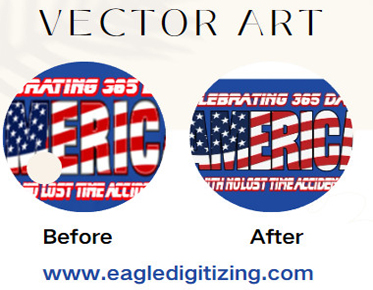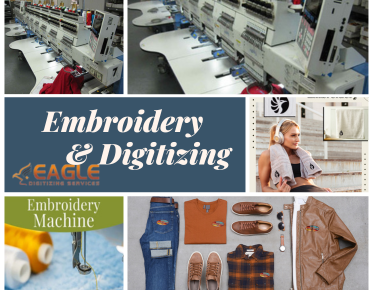Embroidery Digitizing: A Modern Creative Technique for Branding and Personalization
Embroidery digitizing is a modern technique that replicates an image or design onto various products, gifts, and textures, such as caps and branded apparel. While the term "embroidery" often brings to mind the traditional sewing of fabrics, embroidery digitizing is different. It is the process of converting an image or text into stitches using specialized software. However, even with sophisticated software, the role of a skilled embroidery digitizer is essential. These experts create specialized files that are interpreted by embroidery machines to produce high-quality results.
The Role of Embroidery Digitizers
Despite advanced software, successful embroidery digitizing requires the expertise of an embroidery digitizer. These professionals are responsible for ensuring that intricate details in designs are preserved during the digitization process. A single mistake, such as incorrect stitch placement or gaps in the design, can lead to significant losses and dissatisfaction from clients. Common errors, like jagged text or uneven lines, are immediately visible, which can undermine the professionalism of the embroidered product.
Embroidery in Corporate Branding
Embroidery digitizing has gained immense popularity in the corporate world as an effective marketing tool. Many companies use embroidered products such as uniforms, bags, and promotional items to promote their brand. Logos and branding elements are carefully digitized and embroidered onto items, serving as a subtle yet powerful advertising method. As the embroidery process focuses on preserving the brand's integrity, it ensures that the smallest details, such as artwork and outlines, are well-executed.
Companies using embroidery digitizing for branding can also enjoy long-term benefits. Products embroidered with logos and taglines help increase brand visibility and customer recognition. This method allows businesses to create customized promotional gifts that are both practical and appealing to customers.
The Popularity of Embroidery in Personal Life
Embroidery digitizing has become a staple in personal life as well, where people often opt for custom embroidery when preparing unique gifts. Popular items for personal embroidery include T-shirts, towels, badges, trousers, and bags. These customized embroidered products are perfect for celebrating special occasions, such as birthdays, weddings, or anniversaries. Machine-embroidered items are also more affordable compared to hand-embroidered ones, making them a popular choice for mass production and gifting.
Embroidery products personalized with a logo, name, or design can elevate an individual's or company's presence, increasing appeal and fostering customer loyalty.
Embroidery Digitizing in Sports Promotion
Sports organizations widely use embroidery digitizing to enhance their branding efforts. Sports teams often have their logos or mascots embroidered on jerseys, hats, and other merchandise to build a sense of team pride and identity. Fans who purchase these embroidered products promote the organization further by wearing them. This marketing strategy is effective in building a loyal fan base and increasing brand visibility.
Investing in embroidered merchandise allows organizations to gain substantial returns. Given the emotional connection people have with their favorite sports teams, branded products carry immense value for both the organization and its supporters.
Techniques in Embroidery Digitizing: Small Lettering and 3D Effects
When it comes to embroidery digitizing, several advanced techniques are used to achieve different effects. Digitizers often work with small lettering, cap logos, patches, 3D designs, and 3D effects to bring out the best in embroidery. These elements require precision and expertise to ensure that the embroidery looks clean and professional.
For example, digitizing small lettering can be challenging, as letters need to be crisp and legible even when reduced in size. Similarly, creating 3D effects on embroidery adds depth and texture, making the design stand out. This is a popular technique for logos on caps and uniforms, which need to be visible from a distance.
Professional Embroidery Digitizing Companies
For those seeking professional results, there are numerous embroidery digitizing companies offering their services. These companies employ experienced designers, embroiders, and digitizers to ensure that the client's vision is brought to life with precision. Whether you need embroidery for business promotion, personal gifts, or sports branding, these companies provide custom digitizing services tailored to your specific needs.
Working with a professional company ensures that the digitized embroidery is of high quality and that any potential issues, such as stitching errors or design gaps, are avoided.
Learning Embroidery Digitizing: Tutorials and Software
Embroidery digitizing is a skill that can be learned with the help of tutorials and software. Many free tutorials are available online for beginners who wish to try their hand at digitizing. There are also free digitizing software programs that provide basic features for creating embroidery designs.
For those who purchase an embroidery machine or specialized software, a free user manual is typically included. These manuals offer step-by-step guidance for operating the machine and mastering the digitizing process. Additionally, books on embroidery digitizing are available for purchase, although they tend to be more expensive.
Access to Free Embroidery Designs
If you're looking to practice your embroidery digitizing skills, there are many websites that offer free embroidery designs for download. These designs can be used for practice or as inspiration for custom creations. Free designs range from simple patterns to more complex artwork, providing a wide variety of options for both beginners and experienced digitizers.
By downloading free designs, you can experiment with different styles and techniques, honing your skills in digitizing and stitching.
Step-by-Step Embroidery Digitizing Tutorial
If you're new to embroidery digitizing, here is a brief tutorial to help you get started:
1. Drawing and Scanning the Design
Start by drawing the design or selecting an image you wish to digitize. Use a dark pencil to outline the design on sketch paper. Once complete, scan the drawing into your embroidery digitizing software.
2. Modifying the Design
Open the design in the software's drawing tool area. Make any necessary changes using the available tools. This may include adjusting the size, shape, or details of the design to suit the intended embroidery.
3. Applying Stitch Fill
Once you're satisfied with the design, use the stitch filler tool to apply stitching patterns. This tool allows you to specify how the design will be stitched onto the fabric, ensuring consistent and even stitches.
4. Selecting the Embroidery Area and Color
Choose the area on the fabric where the embroidery will be placed, and select the appropriate thread colors. The software may offer a wide range of color options, allowing you to match your design perfectly.
5. Freehand Fonts and Additional Software
For custom fonts or additional designs, you may need to download extra software. This software can provide additional built-in fonts and design elements for your embroidery project.
6. Transferring the Design to the Machine
After completing the design, transfer it to your embroidery machine via a reader-writer box or USB. Insert the embroidery card into the machine, ensuring that the design is ready for stitching.
7. Hooping and Positioning the Fabric
Finally, hoop the fabric securely in the embroidery machine. Position it correctly so that the design is aligned as needed. Once everything is set, the machine will automatically stitch the design according to your digitized file.
Conclusion
Embroidery digitizing has transformed the way we approach embroidery in both professional and personal contexts. It is a highly creative process that blends technology and craftsmanship, resulting in beautifully stitched designs on a wide range of products. Whether you're looking to promote a brand, celebrate a special occasion, or simply express creativity, embroidery digitization offers endless possibilities.



